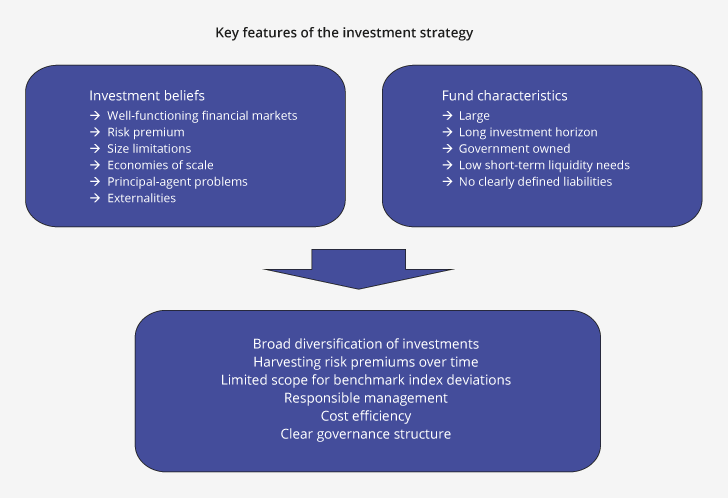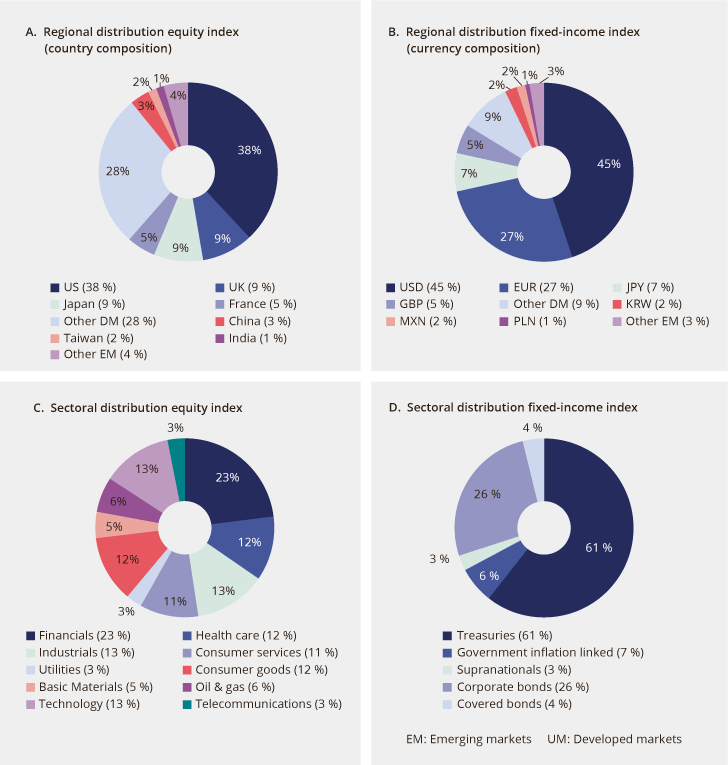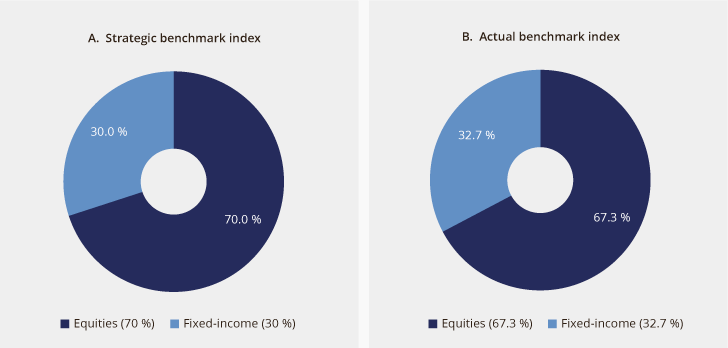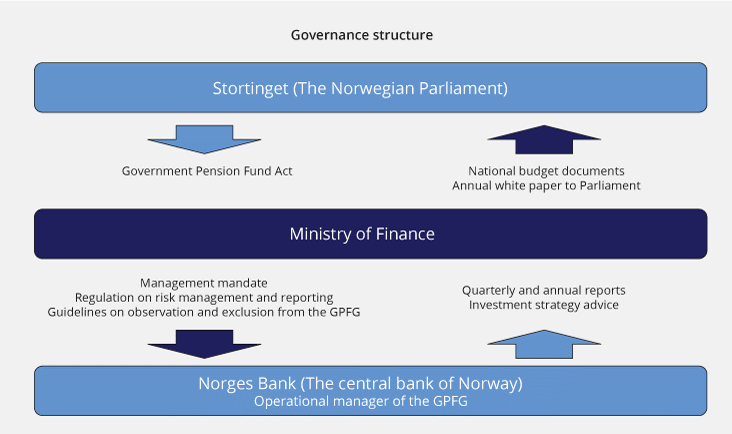2 The Government Pension Fund Global: Strategy
2.1 The current investment strategy
2.1.1 Background
The government is saving the revenues from petroleum activities in the Government Pension Fund Global (GPFG) on an ongoing basis. Such savings are fully integrated into the fiscal budget; see Box 2.1. Annual withdrawals from the Fund; the non-oil deficit, are determined in the fiscal budget. The deficit shall, over time, follow the expected real rate of return on the GPFG (the fiscal policy guidelines).
The GPFG is a financial investor. The management objective is the highest possible return, net of costs and measured in foreign currencies, given an acceptable level of risk. The investment strategy is expressed in the management mandate for the GPFG, which is laid down by the Ministry of Finance. Operational implementation of the management assignment falls within the remit of Norges Bank.
The investment strategy is derived from the purpose of the Fund and its distinctive characteristics, as well as the investment beliefs of the asset owner. It has been developed over time on the basis of public domain knowledge, research, practical experience and thorough assessments. Key features of the investment strategy for the GPFG are summarised in Figure 2.1.

Figure 2.1 Key features of the investment strategy for the Government Pension Fund Global
Source Ministry of Finance.
The benchmark index defined by the Ministry of Finance is closely tracked in the management of the GPFG. More than 99 percent of the volatility in the return on the Fund can be explained by volatility in the return on the benchmark index. There is limited scope for deviations from this benchmark. Norges Bank has over time achieved excess return in its management of the Fund (i.e. outperformed the benchmark).
Transparency is a prerequisite for broad support for, and confidence in, the management of the GPFG. Furthermore, broad support for the key aspects of the management of the Fund is a prerequisite for consistent adherence to the long-term investment strategy, also during periods of financial market turbulence.
Textbox 2.1 The fund structure and the fiscal policy framework
The ongoing inflow of petroleum revenues to the GPFG predominantly represents a conversion of the petroleum wealth on the Norwegian continental shelf into financial wealth abroad. The petroleum revenues differ from other central government revenues in that these represent a conversion of wealth. Moreover, the petroleum revenues are highly volatile and will eventually come to an end.
A key objective of the GPFG and the fiscal policy guidelines is to facilitate permanently high value creation and stable development in the mainland economy. To this end, the central government’s net cash flow from petroleum activities is transferred to the Fund in full. An amount is withdrawn from the Fund annually pursuant to a resolution passed by the Storting to cover the non-oil budget deficit in the fiscal budget.
Since 2001, the following guidelines have applied to withdrawals from Fund (the fiscal policy guidelines):
The spending of fund revenues shall, over time, follow the expected real rate of return on the GPFG.1
Considerable weight shall be attached to the smoothing of fluctuations in the economy to ensure good capacity utilisation and low unemployment.
The Fund and the fiscal policy guidelines serve to shelter the fiscal budget from short-term petroleum revenue fluctuations and provide fiscal policy latitude, thus enabling economic setbacks to be countered. At the same time, petroleum revenue spending via the fiscal budget becomes an integral part of a comprehensive budget process. As long as the central government does not accumulate debt by funding expenditure through borrowing, the capital in the GPFG will reflect real financial savings on the part of central government. The fiscal policy framework facilitates preservation of the real value of the Fund for the benefit of future generations. Whilst the capital of the Fund can only be spent once, the real return may fund a permanently higher level of central government expenditure. The fiscal policy guidelines support the long time horizon of the Fund.
1 In 2017, the Storting endorsed a reduction in the expected real rate of return on the GPFG from four to three percent.
2.1.2 Broad diversification of the investments
A key premise underpinning the investment strategy for the GPFG is that risk can be reduced by broad diversification of investments. This is achieved by diversifying investments across asset classes, countries, sectors, companies and issuers, and makes the Fund less vulnerable to events that impinge on individual investments or individual markets. Diversification enables major parts of the risk specific to individual investments, also called unsystematic risk, to be eliminated and contributes to improving the ratio between expected return and risk in the Fund.
The principle of broad diversification of the investments is reflected in the Ministry’s choice of equity and fixed-income benchmarks. The benchmark indices are based on broad market indices from leading index providers internationally, and comprise several thousand equities and fixed-income instruments. Such market indices are intended to reflect the investment opportunities in international financial markets and may generally be replicated closely and at a low cost. The equity and fixed-income benchmarks for the GPFG specify an investment allocation across countries, currencies, sectors, companies and bonds; see Figure 2.2. The benchmark indices are also a relevant basis for evaluating the performance of Norges Bank’s management of the GPFG. The chosen index providers establish criteria for which markets, companies and issuers to include in the indices.

Figure 2.2 Distribution of the equity and fixed-income benchmarks across geographical regions and sectors as at 31 December 2018
Source Bloomberg, FTSE Russell, Norges Bank and the Ministry of Finance.
The equity benchmark is based on an index provided by FTSE Russell and includes all countries, with the exception of Norway, classified by the index provider as a developed, advanced emerging or secondary emerging market. The allocation of investments within each region is based on the size of the listed equity markets in the countries included in the index, adjusted for free float. The equity benchmark is supplemented by adjustment factors established by the Ministry of Finance for the various countries and markets. The adjustment factors imply that the allocation between regions deviates somewhat from market capitalisation weights in that a larger portion is invested in Europe and a smaller portion in the US and Canada. The Ministry is in this report announcing the commencement of a review of the equity framework and equity benchmark for the GPFG, including the geographical allocation of the index; see the discussion in section 3.4.
The fixed-income benchmark is based on indices provided by Bloomberg, and is comprised of a government bond portion and a corporate bond portion. The government bond portion is 70 percent and comprises nominal government bonds, inflation-linked government bonds and supranational bonds. The corporate bond portion accounts for the remaining 30 percent and comprises corporate and covered bonds. The allocation between the two sub-indices is fixed, with full monthly rebalancing to the chosen weights. Bonds issued in Norwegian kroner or by Norwegian issuers are not included in the benchmark.
Whilst the allocation of investments within the sub-index for corporate bonds is based on market weights, the country allocation within the government bond portion is based on the relative size of the economies as measured by gross domestic product (GDP). Some countries have high GDP relative to the size of their government bond market. Some country weights in the government bond portion are therefore supplemented by adjustment factors established by the Ministry of Finance out of benchmark index investability considerations. The investability requirement is of particular importance in view of the size of the Fund. See section 3.1 for discussion of the new fixed-income framework and benchmark for the GPFG.
2.1.3 Reaping of risk premiums
Broad fluctuations in the market prices of equities, currencies, commodities and interest rates are generally referred to as market risk or systematic risk. According to financial theory, investors can expect to be compensated for accepting this type of risk. The expected return in excess of what can be achieved through a risk-free capital investment is termed a risk premium. Higher systematic risk implies a higher expected return, but also more volatility in the value of the investments and a higher probability of loss.
A key risk premium is the equity premium, i.e. the expected excess return from investing in equities rather than fixed-income securities. Correspondingly, investors will expect a compensation; a so-called credit premium, for the risk that the borrower will default on its obligations. The magnitude of these premiums is uncertain and may vary over time.
Investors differ in their time horizons for investments and in their capacity to absorb risk. The central government, as owner of the GPFG, aims for the petroleum revenues to also benefit future generations of Norwegians. The probability of large and unexpected withdrawals from the Fund is considered to be relatively low. Its long investment horizon makes the GPFG well placed to carry risk that requires a long time horizon. This advantage is exploited in order to, inter alia, harvest the expected excess return from investing in equities rather than fixed-income securities.
The benchmark composition reflects the owner’s trade-off between expected risk and return. For the GPFG, the share of equities in the benchmark is the choice with the greatest impact on total risk and return in the Fund. It has been decided to increase the equity share of the overall strategic benchmark index for the Fund to 70 percent;1 see the discussion in section 3.5. Fixed-income securities represent the remainder of the strategic benchmark index. Fixed-income securities are expected to generate lower return than equities, but also lower risk.
The market prices of equities and fixed-income securities fluctuate considerably, and will often diverge over time. Given these constant price changes, maintaining a fixed allocation between equities and fixed-income securities is considered inexpedient, not least because this may entail unnecessarily high transaction costs for the Fund. An actual benchmark index has therefore been stipulated, in which the equity and fixed-income shares may deviate from their long-term weights, subject to a specified limit. Figure 2.3 shows the composition of the strategic and actual benchmark indices for the GPFG as at the end of 2018.

Figure 2.3 Composition of the strategic and actual benchmark indices for the GPFG as at the end of 2018
Source Norges Bank and the Ministry of Finance.
If the equity share in the actual benchmark index is materially higher or lower than the strategic allocation, this may result in different risk and expected return characteristics than originally endorsed through the choice of equity share. The Ministry of Finance has therefore adopted provisions on the rebalancing of the equity share when the deviation exceeds the stipulated limits. Rebalancing also gives the investment strategy a certain counter-cyclical element, in that over time the Fund purchases the asset class which in relative terms has depreciated substantially in value and sells the asset class which has appreciated strongly in relative terms. Special rebalancing provisions have been adopted for the period when the equity share is being increased from 62.5 percent to 70 percent. The Ministry has in this report assessed the need for modifying the rebalancing provisions in view of the increase in the equity share to 70 percent; see the discussion in section 3.3.
2.1.4 Limited scope for deviations from the benchmark index
The investment strategy for the GPFG is premised on financial markets largely being well-functioning. Competition between market participants is generally high, and new publicly available information is thus assumed to be rapidly reflected in securities prices. Hence, systematically outperforming the general market, as measured by the performance of the average investor, in well-functioning markets will be difficult. This suggests that investors should diversify their investments broadly and seek to minimise asset management costs.
Some investors may nonetheless have distinctive characteristics or advantages which allow them to achieve an excess return over time. Size is a distinctive characteristic of the GPFG, which the Fund may exploit to reap economies of scale. Size may, at the same time, be a disadvantage, since some management strategies are difficult to scale up. It may also prove challenging to make large portfolio adjustments within a short period of time without incurring high transaction costs.
The mandate laid down by the Ministry of Finance for the GPFG allows Norges Bank to deviate somewhat from the benchmark index. The purpose of such deviations is to utilise the distinctive characteristics and advantages of the Fund to achieve excess return and ensure cost-effective management. Continuous modifications to the composition of the actual portfolio require market knowledge and proximity, and the implementation of such adjustments has therefore been delegated to Norges Bank. The scope for deviations is also utilised to meet environment-related investment requirements in the mandate, as well as requirements to take account of fiscal strength in government bond management.
The scope for deviations from the benchmark index is specified in terms of expected tracking error in the mandate for the GPFG, and is stipulated at 1.25 percentage points. Expected tracking error expresses how much the return on the actual portfolio is expected to deviate from the benchmark index in a normal year.
The mandate also defines the financial instruments in which the fund capital may be invested (the investment universe) and stipulates other requirements to curtail the risk associated with deviations from the benchmark. The Fund may, inter alia, only be invested outside Norway, only in tradable debt instruments and only in equities which are listed or planned listed on recognised market places. Furthermore, the Fund may only own up to 10 percent of the voting shares of any one company.2 There are, moreover, mandate provisions intended to ensure a high degree of overlap between the actual investments and the benchmark index.
The benchmark index specifies the desired allocation of capital across the asset classes equities and fixed-income instruments, as well as geographical regions, markets and currencies, and provides a detailed description of how the Fund should, as a general rule, be invested. This distinguishes the GPFG from some other large funds, for which the role of the benchmark index is to define overall risk limits, whilst the detailed investment composition is delegated to the manager. The strategy for the GPFG implies that Fund risk and return are predominantly determined by the benchmark index.
The mandate from the Ministry allows for Norges Bank to invest a minor portion of the GPFG in unlisted real estate. It is more difficult to measure return and manage risk in the unlisted market than in the listed market, and there are no suitable benchmark indices that can be replicated closely and at a low cost. The investments cannot be diversified broadly via small ownership stakes in a large number of properties in a simple and cost-effective manner. Achieved performance will depend on the manager’s strengths and specific investment choices. Unlisted real estate has therefore been made subject to the limit on expected tracking error, alongside other deviations from the benchmark index. The scale and scope of the real estate investments are determined by the operational management choices made by Norges Bank.
The mandate for the GPFG imposes extensive reporting requirements on Norges Bank with regard to risk, return and cost, also for individual strategies used in its management of the Fund. The performance of the equity and fixed-income portfolios is measured against the respective benchmark indices. The performance of these portfolios may be affected by the equities and fixed-income securities divested in order to fund the purchase of unlisted real estate. The contribution from such funding shall therefore be specified separately. The overall benchmark index is a performance measure for the investments of the GPFG as a whole.
The Ministry is in this report proposing to allow for unlisted renewable energy infrastructure within the scope of the environment-related mandates; see the discussion in section 3.2.
2.1.5 Responsible management
The GPFG shall be managed responsibly within the overarching financial objective. The mandate laid down by the Ministry is, at the same time, based on the premise that good financial returns over time will depend on well-functioning markets and sustainable development.
Responsible investment efforts, including principle and standard setting, exercise of ownership and risk management, are integral parts of the management of the Fund. The Executive Board of Norges Bank also makes decisions on observation and exclusion of companies based on recommendations from the Council on Ethics in accordance with the ethically motivated guidelines laid down by the Ministry. However, the GPFG is not a suited vehicle for attending to all forms of commitments incumbent on Norway. There is a broad consensus that the Fund shall not be used as a foreign policy or climate policy tool.
The responsible investment framework is discussed in further detail in chapter 4.
2.1.6 Cost effectiveness
The Ministry of Finance emphasises cost-effective management of the GPFG. A number of conditions facilitate low costs in the management of the Fund. The investment strategy involves the GPFG being predominantly invested in listed equities and fixed-income securities, whilst the scope for deviations from the benchmark index is limited. Management costs will generally increase with the degree of active management, the scope of unlisted investments and the portion of the capital managed externally. Moreover, the size of the Fund enables economies of scale to be exploited and internal expertise to be developed. Management costs, measured as a portion of fund capital, will typically be lower for a large fund than for a small fund. Comparisons with other large funds show that the management costs of the GPFG are low, measured as a portion of assets under management.
Norges Bank shall seek to generate the highest possible return, net of costs. Assessments of Norges Bank’s performance in its execution of the management assignment therefore require both costs and excess return achieved to be examined over time. Passive (index) management will normally entail lower management costs than that of active management, but will also offer less scope for seeking excess return. A comparison of passive and active management must also take into account that the return on the benchmark index cannot be achieved at zero cost. This is, inter alia, because securities trading involves transaction costs.
The actual management costs of Norges Bank are covered up to a maximum limit stipulated annually by the Ministry of Finance. Such limit is specified as a portion of the assets of the GPFG. The Supervisory Council of Norges Bank adopts, within such limit, a budget for Norges Bank’s management of the GPFG, as it does for the other activities of the Bank, based on a proposal from the Executive Board of Norges Bank.
2.1.7 Clear governance structure
The Storting, the Ministry of Finance and Norges Bank have different roles in the management of the GPFG. The Storting has, under the Government Pension Fund Act, made the Ministry of Finance responsible for the management of the GPFG. Norges Bank is responsible for operational implementation. A clear division of roles between the various governance levels, from the Storting down to the individual portfolio manager, clarifies responsibilities. Tasks and authorisations are delegated downwards in the system, whereas performance and risk are reported upwards; see Figure 2.4. Regulations and delegations necessarily become more detailed further down in the hierarchy. Each level has its own supervisory unit which receives reports from, and supervises, its subordinate unit. The exception to this principle is that the Executive Board of Norges Bank is subject to the supervision of the Supervisory Council, a governing body appointed by the Storting, which also appoints Norges Bank’s auditor. The Supervisory Council of Norges Bank reports to the Storting.

Figure 2.4 Governance structure of the GPFG
Source Ministry of Finance.
There is a broad consensus that major strategic choices, such as key decisions on the level of risk to be assumed in the management of the Fund, shall be endorsed by the Storting prior to implementation. The deliberation of the annual white paper on the Government Pension Fund is an important aspect of such endorsement process. Broad endorsement and proper appreciation of the risk profile of the Fund furthers consistent adherence to the investment strategy over time, also during periods of financial market turbulence. The governance structure facilitates endorsement of the investment strategy and the risk profile by the owner, represented by the Storting.
The governance structure must at the same time be sufficiently flexible, through the delegation of authority, to enable ongoing operational investment decisions to be made close to the markets in which the Fund is invested. It is neither desirable, nor feasible, for the operational management of the GPFG to be regulated and managed in detail by the Ministry of Finance. The mandate expresses the overarching investment strategy and limits. Norges Bank is required under the mandate to make investment decisions independently of the Ministry. Such independence also pertains to the exercise of the ownership rights conferred by the investments. This division of responsibilities is broadly endorsed by the Storting.
A sound governance structure should also facilitate the highest possible alignment of interests of the person issuing an assignment (the principal) and the decision-maker (the agent). In practice, the delegation of authority may nonetheless give rise to conflicts of interest because the principal and the agent may have conflicting interests or different information; so-called principal-agent problems. Such conflicts of interest may arise at different levels, for example between the owners and the board of directors of an enterprise, or between the board of directors and the senior executives. In asset management there may be conflicts of interest between the capital owner and the asset manager.
Footnotes
In 2017, the Storting endorsed an increase in the equity share of the strategic benchmark index for the GPFG from 62.5 percent to 70 percent. The phase-in is to be carried out over time in accordance with a plan established in consultation with Norges Bank.
An exception has been made in respect of real estate companies.